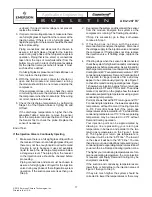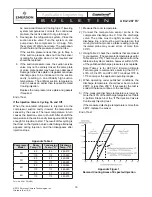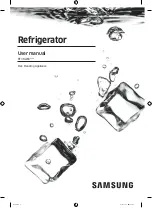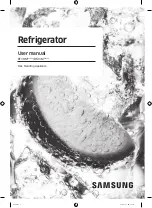
15
© 2012 Emerson Climate Technologies, Inc.
Printed in the U.S.A.
AE4-1287 R7
Application Engineering
B
U
L
L
E
T
I
N
Copeland
®
Demand Cooling
®
Diagnostics
Demand Cooling Operating Characteristics
The Copeland
®
Demand Cooling
®
control uses a
Negative Temperature Coef
fi
cient Thermistor (NTC).
Incorporated in the Demand Cooling Temperature Sensor
(hereafter called “sensor”), is a compressor discharge
temperature monitor. When the temperature sensed
by the NTC Thermistor rises, its resistance falls, and
when temperature sensed by the thermistor drops, its
resistance increases.
The sensor resistance signal is coupled to the Demand
Cooling Module (hereafter called “module”). The module
uses the signal to determine when the compressor
discharge temperature has risen to a point where
Demand Cooling is required. When Demand Cooling
is required the module energizes the Demand Cooling
Injection Valve (hereafter called “injection valve”) and
the injection valve injects saturated refrigerant into
the compressor suction cavity until the discharge
temperature drops to an acceptable level.
Whenever the compressor starts and the module
fi
rst
receives power, there is a one minute delay during
which the Demand Cooling system injects saturated
refrigerant if it is required, but waits for compressor
discharge temperature to stabilize before checking for
alarm conditions. After one minute, if the resistance of
the probe is too low (the resistance equivalent of 310°F),
or too high (the resistance equivalent of 4°F) the module
will trip and deenergize the compressor.
Bench Testing Demand Cooling Components
Bench Check of the Sensor
Required Equipment:
• A digital thermometer of +/- 1 % full scale accuracy.
The thermometer probe should be checked for
calibration in an ice water bath or compared with
another accurately known temperature source.
• A digital ohmmeter capable of +/- 1 % accuracy. The
ohmmeter should be checked for accuracy with a
known resistance value such as a +1 % resistor.
Room temperature should be stable and between 60°F
and 110°F.
1. Wrap the end of the digital thermometer probe
and the metal end of the Demand Cooling sensor
probe together with electrical tape or “Velcro”. The
end of the probe and the end of the thermometer
must touch.
2. Place the wrapped probe-sensor inside an
insulation shield to protect it from air currents. Use
a material such as “Permagum” or piping insulation
such as “Arma
fl
eX”. The insulating material should
be tightly wrapped around the taped-sensor and
the wrap should be secured with wire or tiewraps if
necessary. There should be no free air movement
over the metal part of the taped-sensor.
3. Connect the digital ohmmeter to the two pins on
the plug of the sensor. Make sure there is a good
connection. Do not take a sensor resistance
measurement until there is no change in the
ohmmeter display.
4. Measure the temperature of the thermometer
sensor and find the corresponding calculated
sensor resistance value from Table 1. Since the
values of Table 1 are not continuous, you may
have to interpolate.
5. The sensor resistance reading should be within
+/- 5% of the calculated resistance value of Step 4.
End of Test
Appendix Table 1
Appendix
Thermometer
Temp. (F°)
Calculated
Sensor
Resistance
(Ohms)
59
141426
60.8
135000
62.6
128907
64.4
123129
66.2
117639
68
112437
69.8
107478
71.6
102762
73.4
98289
75.2
94041
77
90000
78.8
86139
80.6
82476
82.4
78984
84.2
75663
Thermometer
Temp. (F°)
Calculated
Sensor
Resistance
(Ohms)
86
72504
87.8
69480
89.6
66609
91.4
63864
93.2
61254
95
58770
96.8
56394
98.6
54126
100.4
51966
102.2
49914
104
47943
105.8
46053
107.6
44262
109.4
42543




































